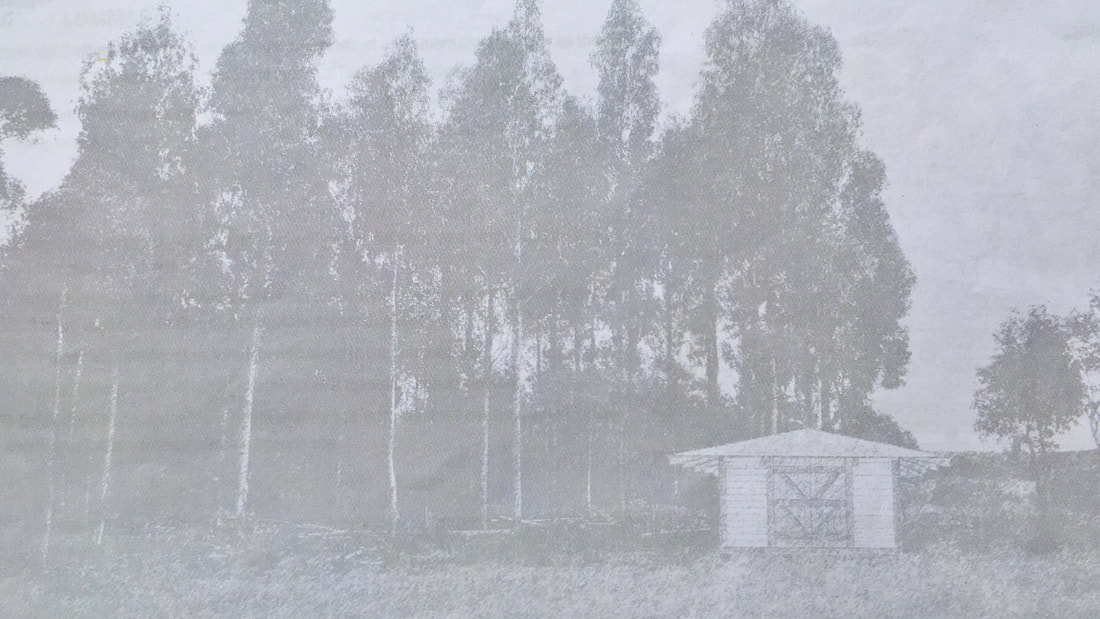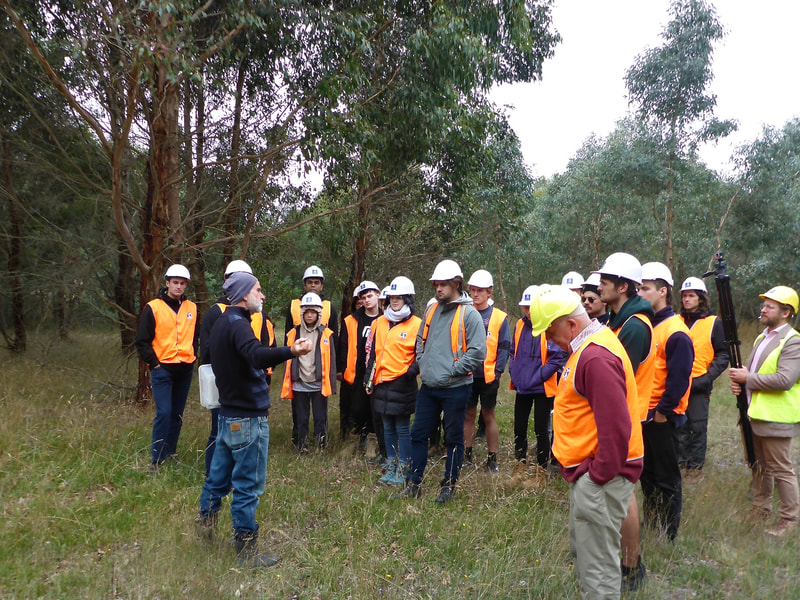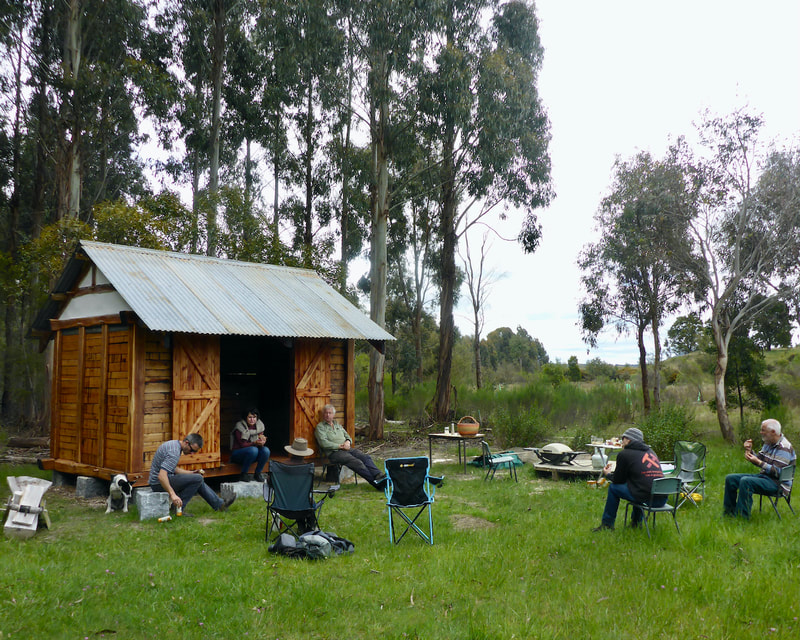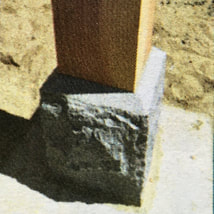Meet the 21st century drop slab hut
|
Lachlan Park, wood craftsman, has designed and constructed a truly special and updated version of the Aussie drop slab hut for Ballarat Region Treegrowers in a clearing at the ImLal biorich plantation. Check his background on his website
|
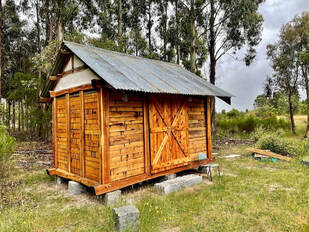 The completed hut in December 2021.
The completed hut in December 2021.
The 21st century drop slab hut project showcases and retrofits proven old ways of building with wood more suited to the rhythms of the earth. It connects people to place, to the planet and to other species.
It’s about using trees, the most renewable of material resources.
But not through mass production in distant places. The trees are local species, individually selected and felled. The wood was cut green and crafted on the spot to create a cultural artefact of lasting strength and beauty. Even the granite stone foundations are designed to reduce embedded energy in the hut’s construction. Unlike a concrete slab or a steel frame, the hut will sit lightly on the earth.
It’s about teaching young people, in particular, how we can connect conservation and production, the only pathway we have to a truly sustainable future.
A community education tool, the drop slab hut stands in a clearing within the ImLal biorich plantation and offers a focus for meetings, shelter, a place for meals and storage. A demonstration project, ImLal pursues the binary goals of optimising biodiversity and therefore habitat, while producing useful resources from timber to seeds, foliage and locally rare endangered plants. The hut acts as a practical example of this binary approach of keeping and caring for country – just as the First Australians did for 65,000 years prior to settlement.
It's a creative design update in keeping with our past heritage.
Drop slab walling is a uniquely Australian method of hut building. Pegging the frame together in mortise and tenon style brings back an attractive building technique from the pre-industrial era when construction in ‘green’ wood was the norm. The wide eaves offer shelter and shade, as country homestead verandas once did. The raised foundation stones allow for timber flooring and adequate airflow.
It's simple and practical.
The structure is both temporary and transportable. Construction is replicable, utilising a limited range of easily available and mostly inexpensive tools. From start to finish, bringing the project to fruition has not relied on energy-inefficient, external value chains.
It’s a small step in the direction of changing our cultural values so they head down a more sustainable pathway.
It’s about using trees, the most renewable of material resources.
But not through mass production in distant places. The trees are local species, individually selected and felled. The wood was cut green and crafted on the spot to create a cultural artefact of lasting strength and beauty. Even the granite stone foundations are designed to reduce embedded energy in the hut’s construction. Unlike a concrete slab or a steel frame, the hut will sit lightly on the earth.
It’s about teaching young people, in particular, how we can connect conservation and production, the only pathway we have to a truly sustainable future.
A community education tool, the drop slab hut stands in a clearing within the ImLal biorich plantation and offers a focus for meetings, shelter, a place for meals and storage. A demonstration project, ImLal pursues the binary goals of optimising biodiversity and therefore habitat, while producing useful resources from timber to seeds, foliage and locally rare endangered plants. The hut acts as a practical example of this binary approach of keeping and caring for country – just as the First Australians did for 65,000 years prior to settlement.
It's a creative design update in keeping with our past heritage.
Drop slab walling is a uniquely Australian method of hut building. Pegging the frame together in mortise and tenon style brings back an attractive building technique from the pre-industrial era when construction in ‘green’ wood was the norm. The wide eaves offer shelter and shade, as country homestead verandas once did. The raised foundation stones allow for timber flooring and adequate airflow.
It's simple and practical.
The structure is both temporary and transportable. Construction is replicable, utilising a limited range of easily available and mostly inexpensive tools. From start to finish, bringing the project to fruition has not relied on energy-inefficient, external value chains.
It’s a small step in the direction of changing our cultural values so they head down a more sustainable pathway.
"The Moorabool Landcare Network are keen to see this project increase the value of the Imlal site that is important to a developing community. It provides copious learning opportunities to the broader community from the revegetation, forestry and ecological works on site. |
Contemporary and refined in design
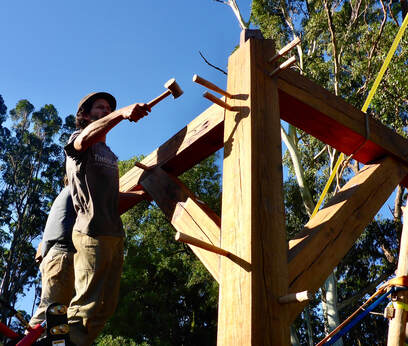 Lachlan pegging the frame of a green wood shed.
Lachlan pegging the frame of a green wood shed.
Refreshing the traditional hut design by combining the best of the old:-
> posts and beams pegged together in pre-industrial method of mortise(slotted post-top)and tenon (chiselled beam-end to fit slot)
> beautifully hand crafted so as to be aesthetically pleasing
> drop slab horizontal wall construction that is uniquely Australian
> colonial-style wide veranda and corrugated iron gable roof
> local plantation-grown, rough sawn black wattle flooring
> on a foundation of rugged granite staddle stones.
> posts and beams pegged together in pre-industrial method of mortise(slotted post-top)and tenon (chiselled beam-end to fit slot)
> beautifully hand crafted so as to be aesthetically pleasing
> drop slab horizontal wall construction that is uniquely Australian
> colonial-style wide veranda and corrugated iron gable roof
> local plantation-grown, rough sawn black wattle flooring
> on a foundation of rugged granite staddle stones.
Made of local, renewable materials
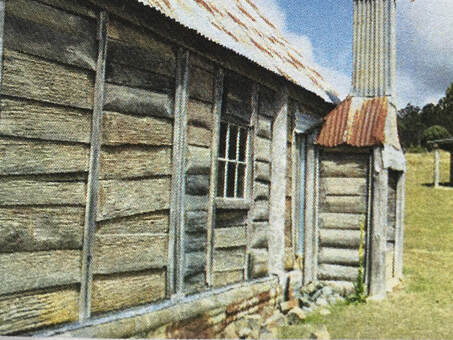 Traditional drop slab walls on a cattleman's hut.
Traditional drop slab walls on a cattleman's hut.
Using traditional techniques to better conserve resources:-
> working with wood when green reduces embedded energy
> thick 2 inch slab walls will naturally insulate (R-value of almost 3.0)
> timber as the primary material – far more renewable than concrete or steel
> wide veranda on all sides will offer shade from the sun and protection from rain
> staddle stones ensure air circulation and termite prevention.
> working with wood when green reduces embedded energy
> thick 2 inch slab walls will naturally insulate (R-value of almost 3.0)
> timber as the primary material – far more renewable than concrete or steel
> wide veranda on all sides will offer shade from the sun and protection from rain
> staddle stones ensure air circulation and termite prevention.
Uniquely practical and creative elements
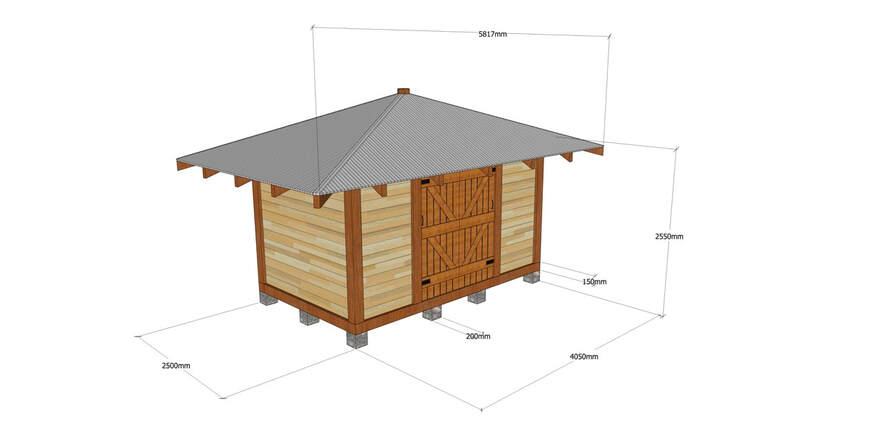 Hut elements and dimensions. Sketch by Lachlan Park
Hut elements and dimensions. Sketch by Lachlan Park
Showcasing local sustainably-grown timbers and bringing back ‘lost’ arts:-
> sugar gum for posts & beams; messmate for walls; black wattle for floors and window frames
> sugar gum is plantation-grown and a Class 1 naturally durable timber, largely wasted
as firewood at present
> messmate stringybark splits easily and was once widely used in hut building
> a lustrous wavy-red timber, black wattle is fast-growing, hard-wearing and all but forgotten
> an in situ building process that takes advantage of local materials, mortise and tenon
pre-dates the mechanisation and truck haulage of the modern timber industry
> slabbing is a simple technique, for which messmate is ideal
> staddle stones avoid the need for high embedded energy concrete foundations.
Exemplar of ‘small is beautiful’ mantra
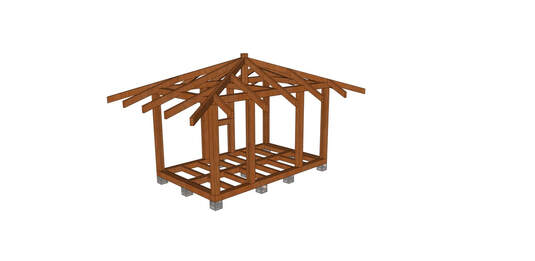 Hut pegged frame in messmate. Sketch by Lachlan Park
Hut pegged frame in messmate. Sketch by Lachlan Park
Keeping it simple and small in scale:-
> a single room with colour-washed walls showing the texture of saw marks
> at 10m2, the hut is under the size where a planning permit is required
> size and placement of staddle stones will ensure it’s transportable
> wide veranda offers a platform for speakers and a sheltered place for meetings and meals
> the hut will act as a focus for field trips, meetings and as storage for chairs, table, BBQ, products and tools.
> a single room with colour-washed walls showing the texture of saw marks
> at 10m2, the hut is under the size where a planning permit is required
> size and placement of staddle stones will ensure it’s transportable
> wide veranda offers a platform for speakers and a sheltered place for meetings and meals
> the hut will act as a focus for field trips, meetings and as storage for chairs, table, BBQ, products and tools.
